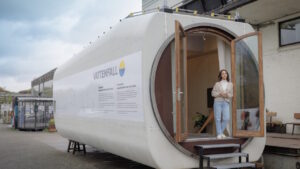One of Australia’s largest untapped solar PV markets – the 1.8 million vacant rooftops estimated to belong to the residential rental market – is being targeted by a Sydney-based solar group, which says the time is right for property investors to start benefiting from solar savings.
Prepaid Solar, whose Prepaid Meter utility technology is already being used around Australia in sub-meter solar projects for bodies corporate, says the local market has passed the tipping point where solar can make money for landlords, with discounts passed on to tenants.
The sub-metering system allows property owners to take over the retail power bill and charge the tenants a discounted rate – often a 5 per cent discount on the total electricity bill.
For tenants, the ability to monitor and manage their power usage gives them the potential to save between 10-15 per cent on electricity through efficiency, once the meter is installed. It also offers the benefit of lower and more predictable power bills.
 According to Prepaid Solar, returns for investors above 20 per cent – or 40 per cent on some commercial sites – payback would occur quickly, leaving landlords with “free electricity” to sell to their tenants for the next 20 years.
According to Prepaid Solar, returns for investors above 20 per cent – or 40 per cent on some commercial sites – payback would occur quickly, leaving landlords with “free electricity” to sell to their tenants for the next 20 years.
“This is a way for landlords to participate (in distributed solar power generation) and get the benefits and still be able to provide their tenants with cheaper power,” said Prepaid Solar managing director, Vincent Selleck, in an interview with RenewEconomy.
“It’s just at that point where it works.
“Prepaid Metering allows more distribution of ownership with commercial benefits like depreciation and provides a great alternative to Power Purchase Agreements (PPA’s) being rolled out by large emerging solar retailers now.”
Selleck says the sub-metering approach is also ideal for use in granny flats, apartment buildings, community solar farms and eco-villages.
On Queensland’s Gold Coast, the Varsity Towers student accommodation building, which mostly houses students from the nearby Bond University, has installed 305 Prepaid Meters, allowing the building’s owners to cap their excessive electricity bills and make students more aware of their energy usage.
Once installed, the prepaid metering system ensures all owners or their tenants prepay for power before being supplied, resulting in an immediate improvement in the cash flow of the building’s body corporate. The sub-meters also obviate the need for meter reading services and the associated costs.

In Varsity Towers, Students prepay for a “fair allocation” of electricity, and a meter located in each apartment counts backwards from the credited amount, showing current electrical usage and the balance remaining.
The meter warns students when their credit is running low, giving them the option of cutting back on usage, or buying more electricity via phone, internet or at the building site.
Selleck is confident solar for rental properties is a big potential market in Australia, which he says is “way behind” the rest of the world on use of the sub-metering technology.
“This market for landlords … still creates a positive outcome, regardless of whether there’s a RET there or not,” he added, referring to the latest rumours that the Coalition is pushing for Australia’s Renewable Energy Target to be dumped altogether.
And, he adds, when cost-competitive battery storage becomes available, “you’ve got an automatic upgrade path.”
“Once we add storage to the system next year, a decentralised power production industry will flourish and change the way power is distributed and sold in Australia,” Selleck said.










